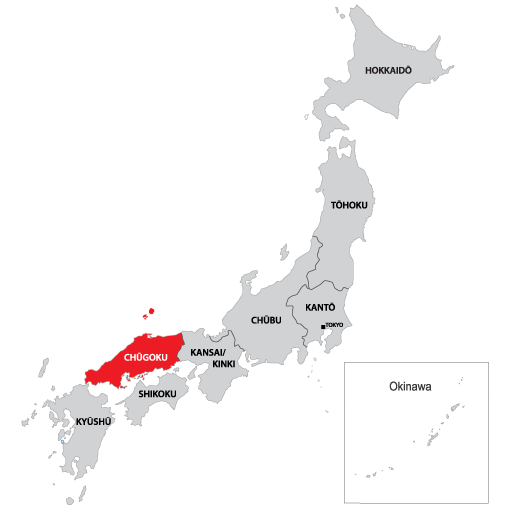
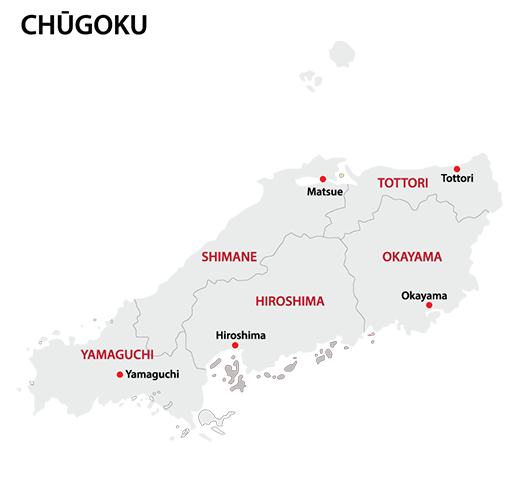
The Chugoku area is known for its coastlines, bordered on one side by the Seto Inland Sea, and the other by the Sea of Japan.
A westward journey in Chugoku ends at the far western end of the main Honshu Island, at the Shimonoseki Straits, which separate Japan’s main island of Honshu, from the island of Kyushu. Much of Chugoku falls off the usual tourist route, making it a wonderful area to discover the ‘hidden’ Japan off the beaten path.
Tottori Prefecture
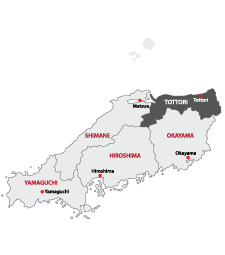 On the Sea of Japan side, west of northern Kyoto prefecture, we come to Tottori. Tottori is one of the least visited prefectures of Japan, and is amongst its smallest in population – only 600,000 live in the prefecture. The prefecture can not be accessed by bullet train – only limited express and local trains operate on the Sea of Japan side of Chugoku, which means it is often bypassed by visitors who are pressed for time, but the area is worth a visit.
On the Sea of Japan side, west of northern Kyoto prefecture, we come to Tottori. Tottori is one of the least visited prefectures of Japan, and is amongst its smallest in population – only 600,000 live in the prefecture. The prefecture can not be accessed by bullet train – only limited express and local trains operate on the Sea of Japan side of Chugoku, which means it is often bypassed by visitors who are pressed for time, but the area is worth a visit.
Tottori is probably most famous for the sand dunes – Japan’s largest – which are very much a part of the local tourist path. The dunes are a popular spot to visit domestically and when enjoying the dunes you can pose for a photograph with a camel following a ride, or can boogie board down some of the dunes. Nearby, for good measure, is the Sand Museum, which has annual displays of ornate and masterful sand sculptures depicting a region of the world.
The San’in Kaigan Geopark is home to a beautiful undulating coastline, with dramatic cliffs and stone features. The Uradome coast is popular for its small fishing villages, as well as coastal walks and sea kayaking. Standout areas include Sengan Matsushima Island, Kamogaiso Beach, and the Nantane Goto Islands. Getting away from the sea leads to forested areas where forest bathing can be practiced at a dedicated center near Chizu.
Mt. Daisen is the tallest peak in the Chugoku region and is popular in the winter for skiing, and in summer for its climbing routes. Daisen-ji temple, located at the foot of Mt. Daisen, is the Buddhist Temple that marks the trailhead for the Natsuyama hiking path up the mountain to Misen Peak as well as to a broader mix of hiking trails to the North West of the mountain. Ogamiyama Shrine also reveres the mountain and takes its name from Mountain of the Great God – the God of Fire Kagusuchi-no-Mikoto.
Step back into the past in Kurayoshi city, a town retaining preserved Edo period merchant homes or shirakabe. Many are not just vestiges of the past – they continue to trade today in soy sauce, sweets, sake, and other products. The 150-year-old Tsudo Chaho Teahouse is like stepping back in time. Not far from Kurayoshi, the volcanic power of Japan makes itself known at Misasa Onsen. Misasa Onsen is said to have been discovered 850 years ago. Its soothing waters are high in radium.
Mt. Mitoku is a sacred mountain, where those who follow Shugendo seek to become closer to the divine with the practice of their faith through challenge. Nageiredo – a hall that forms a part of the Sanbutsuji temple, perches like a bird on a cliffside at Mt. Mitoku, The creation of this temple at such a high and inaccessible spot can only be seen as a dedicated act of devotion. Monjudo, another hall, has commanding views for the very brave over the valley below. The porch of this hall has no barrier between it and the long drop to the valley floor. Jizodo is built in a similar style.
During cherry blossom season, the grounds of the Shikano Castle ruins contain nearly 500 cherry trees which once delighted the residents of the castle. The Tottori Castle Ruins park and Inaba Senbonzakura areas are other locations that can be found right in Tottori city.
Tottori city is the main transportation hub of the area and, in addition to the Tottori Castle Ruins, you’ll find Kannon-in Temple, a strolling garden with extensive and beautiful grounds.
Sakaiminato is well renowned for its shellfish and is the port where a commanding amount of shellfish is processed. During the winter months, the area is a draw for lovers of snow crab. It also is home to a sanctuary for water birds, for those who wish to explore the local wildlife. Sakaiminato is also a great jumping-off point to visit the Oki Islands, 3 islands set in the Sea of Japan that are a part of Shimane prefecture.
Anime lovers may wish to make a pilgrimage of their own to Yonago, the birthplace of the artist of the manga series Ge Ge Ge Kitaro. Walking through the town you may see figures based on the manga’s characters. The author of Detective Conan also called Yonago home, and there is a facility in the area dedicated to his works.
On the eastern edge of Tottori the Kinrinjishi – a local form of Lion dance is performed for special occasions.
For those with a strong interest in local crafts, the vibrant glazes of pottery fired at the Inshu Nakai kiln combine centuries of tradition with bright colours that do not seem out of place in modern settings. Bamboo crafts are also a mainstay of this region. In addition to crab and shrimp and a variety of seafood and shellfish, Tottori is also known for its production of Asian pears, persimmons, and shallots.



Okayama Prefecture
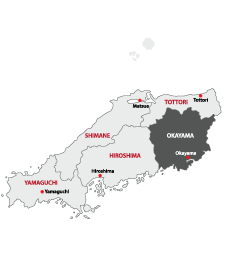 South of Tottori, on the Seto Inland Sea side of Japan, on the San’yo bullet train route, is Okayama prefecture. Okayama is a hub for transport north and south from this route. In Western Japan, Okayama was the heart of the former Kibi kingdom, which was one of the power centers of historic Japan. The area is also associated with the fable of Momotaro, a boy that was found by an older childless couple in a peach, who later slew local demons to protect the people and win the hearts and gratitude of all. Okayama prefecture is known for its fruit production – particularly of peaches and grapes.
South of Tottori, on the Seto Inland Sea side of Japan, on the San’yo bullet train route, is Okayama prefecture. Okayama is a hub for transport north and south from this route. In Western Japan, Okayama was the heart of the former Kibi kingdom, which was one of the power centers of historic Japan. The area is also associated with the fable of Momotaro, a boy that was found by an older childless couple in a peach, who later slew local demons to protect the people and win the hearts and gratitude of all. Okayama prefecture is known for its fruit production – particularly of peaches and grapes.
Okayama City, the capital of the prefecture, is well worth a visit. Formerly an Edo period castle town, its restored castle still stands proudly over the city today, originally built in the late 16th century, the castle was destroyed in World War II, with only the moon-viewing turret remaining. The restored castle now displays exhibits and offers hands-on activities.
Nearby, just across the Asahi river, you’ll find Korakuen Garden, considered by many to be one of Japan’s top 3 gardens. Shortlisted or not, this expansive strolling garden features koi ponds, teahouses, tea and rice plantations, a wooded section, an orchard, as well as manicured lawns and greenery. It is a pleasant location to find a bit of peace, and a paradise for those who like their gardens manicured. It was previously the gardens of the powerful Lords of the Kibi Kingdom, but in the 1800s became part of the city’s public cultural legacy. As is true of many areas where powerful kingdoms and families of Lords held sway, there are a wealth of museums of art and artifacts in the city.
Not far from the city lies the Kibi Plain, which was once the centre of the Kibi kingdom in the 4th century, whose power rivaled that of the Yamato kingdom. The area is associated with the Legend of the Prince Kibitsuhiko-no-Mikoto – dispatched by the Yamato Kingdom to slay demons in the area. By the 7th century, the Kingdom was dispersed. Today many visitors enjoy cycling through the Kibi Plain, visiting the burial mounds and temples on their journey. In what could be a blurring or retelling of the story of Prince Kibitsuhiko, hometown boy Momotaro also fought the demons at their castle, Kinjo-jo, on the Soja end of the Kibi Plain.
A short train journey from Okayama is all that is needed to visit Kurashiki, a popular town with a preserved canal district known as the Bikan Chiku. The warehouses that once stored commercial goods have now been transformed into boutiques, galleries, museums, and restaurants. Weeping willows hang heavily over the canal, and visitors often view the canal from one of the small pole-and-man powered boats through the canal, or by walking along its sides. The Ohara Museum of Art in the district contains works by famous European Japanese artists. The district is closed off to traffic making it an easy and comfortable location to explore. Kurashiki and the nearby port of Kojima are connected to the history of and production of denim in Japan.



The Bizen area, once part of the Kibi Kingdom, and lying on the coast east of Okayama, is known today for its Bizen yaki style of pottery, and production clusters mostly around the town of Inbe. Bizen yaki is known for its unglazed reddish-brown tones and Bizen is one of the six ancient kilns where pottery was created in Japan. The production of Bizen yaki was supported during the Edo period by the Ikeda family, who held power in the area. The style nearly died out during the modern era and was saved through the efforts of Kaneshige Toyo and others in the 1930s who sought to preserve this local craft. Bizen is also home to the Bizen Osafuri Sword Museum.
Ushimado, with its blue seas, views of the emerald islands of the Seto Inland Sea, and its olive groves, has a somewhat Mediterranean feel. Further West, the port of Uno in Okayama prefecture, is a popular jumping-off point for ferries to the art islands of Naoshima and Teshima – formally part of Kagawa prefecture. These islands and the Okayama island of Inujima are all participants in the Setouchi Art Triennale, with temporary installations. There are also permanent displays of art on the island at the Seirensho Art Museum and the Art House project.
The Bitchu Matsuyama Castle is one of Japan’s few remaining original castles and is the last remaining mountain castle of its kind. It is the oldest of the remaining castles in Japan, and at 430m, sits at the highest altitude. Because the castle sits on Mount Gagyu, the mountain sometimes appears to be floating on clouds as the valleys fill with mist, giving the castle the nickname of the ‘Castle in the sky’. At the base of the castle is Takahashi Town, with its old historic precincts, and Raikyuji Temple – a Rinzai Zen temple with a garden said to be designed by the ancient tea master Enshu.
Deeper inland in Takahashi is the Fukiya Bengara village – awash in the red hues of the locally produced Bengara dye. The Fukiya elementary school is the oldest wooden school in Japan. The architecture of Fukiya harks back to the Edo era. The village was once made very wealthy by the copper mine in town and bengara red was historically a status colour. The local heritage is preserved and it is possible to visit a merchant home, the mine, the school, and the bengara factory.
The towns of Tsuyama and Mimasaka are in Northern Okayama. Tsuyama is a historic town that rose to prominence during the Edo period when rule over the town was given to the Tadamasu Mori by Tokugawa Ieyasu. Mori created a stunning castle that was once said to rival Himeji, but which was later destroyed like many others during the Meiji area. The town’s Kakuzan Park is home to the castle ruins and grounds and is known as a magnificent location for viewing cherry blossoms. Mimasaka is home to three hot springs areas – Yunogo Onsen, Yubara Onsen, and Okutsu Onsen – and was also home to the well-known swordsman and samurai, Miyamoto Musashi.
The Hiruzen Highlands span Tottori and Okayama prefectures and are popular for horseback riding, cycling, and mountain trails on Mount Hiruzen, a dormant volcano, and the lower approach to Mount Daisen. Snowboarding and skiing are locally popular in winter. Dairy cows are bred in the highlands here, making it a popular location to enjoy ice cream during the green season.



Hiroshima Prefecture
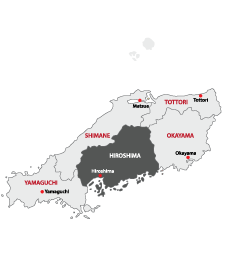 Hiroshima prefecture lies to the West of Okayama prefecture, on the Seto Inland Sea. Hiroshima’s position on the Seto Inland Sea has made it key to trade, commerce, and industry over the centuries. In the 6th and 7th centuries, the area was divided into 4 main divisions – Bihoko in the northeast inland areas, Bingo in the southeast along the Seto Inland Sea, Geihoku, the northwestern inland portion of the area, and Aki, where Hiroshima city and Miyajima sit along the Inland Sea.
Hiroshima prefecture lies to the West of Okayama prefecture, on the Seto Inland Sea. Hiroshima’s position on the Seto Inland Sea has made it key to trade, commerce, and industry over the centuries. In the 6th and 7th centuries, the area was divided into 4 main divisions – Bihoko in the northeast inland areas, Bingo in the southeast along the Seto Inland Sea, Geihoku, the northwestern inland portion of the area, and Aki, where Hiroshima city and Miyajima sit along the Inland Sea.
Bihoko and Geihoko, the inland areas of Hiroshima prefecture, are popular for those who enjoy the mountains and highlands and natural backdrops found in this area. The Taishakukyo Gorge is beautiful in its own right but is also known for mysterious carvings, and the area and nearby birch forests of Mt Hiba are revered as being the resting place of Izanami-no-Mikoto, one of the founding deities of Japan. Within the gorge is a natural limestone bridge, the Onbashi bridge. The limestone also creates a stark backdrop to the Taishakuten Eimyoji Temple. The National Bihoko Hills Park receives many local visitors for its flower gardens, its preserved Hiba no Sato village of traditional buildings, and for the trails and natural pursuits available in the park. Further West, in Geihoku, the dramatic Sandankyo Gorge also offers arresting scenery. Hot springs can be found at various locations in Hiroshima and in the inland areas, the Oasa Kanbiki and Nukui Onsen areas are rich in minerals that are thought by many to ease various physical complaints.
Hiroshima prefecture’s more famous sights are located in the areas of the prefecture along the Setouchi or Seto Inland Sea area. In Bingo, eastern Hiroshima’s largest city is Fukuyama. The town was heavily damaged in air raids during World War II. Fukuyama Castle, originally built in 1622, stands next to the train station and was restored following the war. Shinshoji Temple is a modern Rinzai Zen temple that seeks to provide visitors with a developed Zen experience and can be found south of Fukuyama. The Hiroshima Prefectural Museum of History chronicles life in the Setouchi region over the centuries, and a replica of an excavated port town is a focus of exhibits. For operating port towns, both Tomonoura and Onomichi remain lively.
Tomonoura lies south of Fukuyama city. The old port town is a preserved historical area that has been celebrated in films as varied as Ponyo by the Sea by Studio Ghibli’s master, Miyazaki Hayao, as well as Hollywood blockbuster The Wolverine, and Japanese film White Camellia. It is picturesque with its traditional wooden buildings, and the stone Joyato lighthouse to guide ships home. In any location where residents make a living from the sea, it is common to find signs of religious devotion, and Tomonoura is no exception. Shrines and temples can be found throughout the old port town, and wandering through the lanes will also bring you to restored residences providing a taste of life in the port. The Irohamaru Museum brings a wrecked ship to life again and tells the story of Sakamoto Ryoma, one of Japan’s key historical figures who were on board when it sank. The Taichoro Hall of Fukuzenji Temple offers beautiful views over the sea and Sensuijima Island. Sensuijima is home to a simple ryokan with soothing baths. Tomonoura is also a great location for sea kayaking and exploring the picturesque coastline and islands.
Onomichi, which snakes up the hillside over the port, has become a mecca for artists and craftspeople due to the economical accommodation. This has given the port town youthful energy. Some of that energy may also come from those inspired to cycle the Shimanami Kaido, a 70km cycling route along the bridges that cross the Seto Inland Sea to Imabari on the island of Shikoku. The views are magnificent from the bridge, and a keen cyclist can make the journey in one day, but breaking up the journey into two days with a stay on one of the intermediary islands, allows for a more leisurely discovery of the area and its people. For those who wish to stretch their legs by walking, the city has a Temple walking route that takes walkers up and down the paths and byways of Onomichi to visit 25 temples in the town. Senkoji Temple sits at the highest point and was reputedly built by Kobo Daishi. The port of Onomichi itself has been important to trade in the area since the 1100s. Near Onomichi lie Setoda Sunset Beach, Shimanami Beach, and Tachibana Beach. Onomichi ramen, the local style, is a ‘must try’ variation.



Continuing West along the coast into the Aki area brings us to Takehara, an area of Hiroshima prefecture where historical buildings were not destroyed during the war. These leave the town with a charming feel that has led some to call it the ‘little Tokyo of Aki’. Takehara was a key production area for seaweed salt in summer and sake in winter. Former residences of the Yoshii family and the Matsusaka families illustrate the lives of local merchants. In addition to the town space of wooden Edo period buildings, sake breweries also cluster in the town. Traditional bamboo crafts are also still produced in the area. Takehara takes its name from the Japanese for ‘bamboo field’.
Takehara and nearby Tadenoumi are also accessing points to Okunoshima island, which is also known as ‘rabbit island’. The island was used heavily in the Meiji, Russo-Japanese War and World War II eras as a base and production area, and to this day the vestiges of these abandoned facilities remain on the island. The rabbits currently are the main draw to the island, and it is thought that 900 or more roam around the island.
Continuing west in the Aki area of Hiroshima prefecture brings us to Kure, an important town for the Imperial Navy and now for the Japanese Self Defence Forces. Kure was a shipbuilding hub and is where the famous battleship Yamato was built and launched.
Hiroshima City makes its way onto many visitors’ itineraries as they seek to come to terms with the city’s past, which has in a sense, become the world’s past. In August 1945, Hiroshima was the first city to be targeted with a large-scale nuclear warhead. The destruction and devastation were seen instantly, and a more insidious lasting impact would only be discovered in the months and years following. Looking at the lively and exuberant city today, it is difficult to imagine that time when the city was razed by the blast, which is why the Peace Park and Museum are so important to keep us mindful of that time and to remember all those lost in war, in hopes that peace will prevail.
There are touching memorials spaced around the park. The hypocenter of the bomb was not far from the Hiroshima Prefectural Commercial Product Exhibition Hall, which has been left in its ruined state to show the impact of the blast. It is now known colloquially as the A-bomb dome and is a UNESCO World Heritage site. At the center of the park sits the cenotaph and an eternal flame to commemorate the victims of the bomb. In the outlying areas of the park, burial sites, children memorials, memorials to foreign workers, and the ‘phoenix trees’ that miraculously returned to life following the blast. Many are festooned with paper cranes, representing wishes for peace from children throughout the world. The Museum contains many touching artifacts associated with those who were killed in the bombing and highlights the force of the blast. Testimonials of those that survived also form an important part of the museum.
While this dark time is part of the city’s heritage, the city has a much longer history, dating back to the 6th and 7th centuries. Hiroshima’s castle lies near the train station, and the restored building and donjon now contain opportunities to learn about the castle and the city’s history. The Shukkeien garden also provides a respite from the wartime memorials with a peaceful strolling garden located near the Hiroshima Prefectural Art Museum, with representation from both European and Japanese artists. Heading further outside the city will bring you to the Mazda Museum at the corporation’s headquarters. Basic English tours are offered daily on opening days, but reservations are required. For those with children, the Numaji Transportation Museum, also located outside of the city, displays all sorts of forms of transportation for your budding driver, conductor, or pilot.



The sacred island of Miyajima makes for a wonderful day trip or even a half-day excursion for the time-pressed visitor. Formally the island is known as Itsukushima. Itsukushima Shrine, a UNESCO World Heritage Site, is the primary attraction here, but certainly not the only one. The vermilion shrine is known for its ‘floating torii’ located out at sea and the shrine itself is built on pillions over the island and water. Sacred deer wander freely through the town to the delight of visitors but these curious messengers of the Gods may try to nibble on any paper you have handy as well as food so keep an eye on your documents!
Sitting at the heart of the mountain is Mt. Misen. It is possible to hike up and down the mountain for beautiful views over the Seto Inland Sea from this higher vantage point, and for those who don’t wish to make the trek, there is also a ropeway that travels to the top. It is said that Kobo Daishi came here in the year 806 and established the mountain as a base for Shingon Buddhism. The ropeway can be found in Momijidani park, which takes its name from the maple trees. Because of its significance in both Shintoism and Buddhism, there are other religious sites located on the island, such as Toyokuni Shrine – a vast open ’thousand mat’ sized space that was intended to be developed into a library but which remains compelling today for its emptiness. Daisho-in in the hills of the island also is well worth a visit. Oysters and bean-paste-filled buns shaped like maple leaves – Momiji Manju – are specialties of the island. On the ferry to Miyajima, the oyster cultivation fields stretch along the waterway – taking advantage of the flowing current.
With its position on the water, seafood and oysters are popular foods in Hiroshima prefecture. The area also has its local form of okonomiyaki, which layers ingredients. This savoury pancake style is different from the Osaka variation which mixes all the ingredients together. Try both styles and see which is your favourite! Sake is also a popular product of the region.



Yamaguchi Prefecture
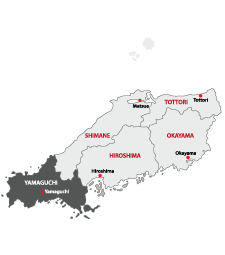 Lying to the far west of the island of Honshu, and divided from the island of Kyushu by the Kanmon Straits at Shimonoseki, in Yamaguchi prefecture. The Prefecture is bordered on the north by the Sea of Japan, and on the south by the Seto inland sea. To the east are Hiroshima and Shimane prefectures. Despite having a bullet train hub at Shin-Yamaguchi station, many visitors travel through the prefecture at great speed as they make their way from points east to Hakata Station in Fukuoka. This rural prefecture does have notable locations that make it worth lingering. It was once the Choshu domain, held by the powerful Mori clan and the samurai have left their mark on the area.
Lying to the far west of the island of Honshu, and divided from the island of Kyushu by the Kanmon Straits at Shimonoseki, in Yamaguchi prefecture. The Prefecture is bordered on the north by the Sea of Japan, and on the south by the Seto inland sea. To the east are Hiroshima and Shimane prefectures. Despite having a bullet train hub at Shin-Yamaguchi station, many visitors travel through the prefecture at great speed as they make their way from points east to Hakata Station in Fukuoka. This rural prefecture does have notable locations that make it worth lingering. It was once the Choshu domain, held by the powerful Mori clan and the samurai have left their mark on the area.
In the area just west of Hiroshima prefecture lies Iwakuni. Iwakuni is famous for the Kintaikyo Bridge, a wooden bridge that undulates in semicircular waves of 5 arches as it crosses the Nishiki River. It was originally built in 1673, in traditional style without the use of any nails. Only samurai could cross this bridge, but now there is no such restriction.
Iwakuni castle sits above the town. Originally constructed in 1691 it was ordered to be decommissioned and destroyed only a few years after it was built by the lords in Hiroshima, who feared it would become a competing base of power to their own. Even though the castle was partially destroyed, the Daimyo kept it as their home. Iwakuni-jo can be reached by a ropeway and includes not just the restored castle, but the ruins of the original.
Kikko Park, located near the Kintaikyo bridge, is particularly popular during cherry blossom season, as 3000 cherry trees line the river and the park. It was once the home of the Lord of Iwakuni and you can see samurai houses on the grounds of the park. The samurai made an impression on the town and the Iwakuni Art Museum also displays samurai armor and examines the danger-filled lives of the samurai.
Iwakuni’s local delicacy is Iwakuni sushi, a pressed sushi dish that includes slightly sweet sushi rice, often topped with vegetables and eggs, and sometimes a cooked prawn. The Iwakuni sushi looks a bit like Chirashi or scattered sushi but is pressed into layers of rice with toppings and then sliced into servings.



Hofu lies further along the coast and is known for its Naked Man Festival. Annually men dressed in nothing but loincloths, to show their equality, parade festival floats through the streets to Hofu Tenmangu shrine. The shrine itself is popular with students, who come to pray for good exam results, as it was the first dedicated to Tenjin, the god of learning. It is one of the three major Tenmangu shrines nationally. The Suo Kokubunji Temple is the only Kokubunji temple of those built in the 800’s to promulgate Buddhism, which has retained its original layout.
The Mori clan, who ruled over the Choshu domain, settled here in Yamaguchi prefecture following their defeat at the battle of Sekigahara. The Mori garden, located near the Hofu Tenmangu shrine, is a more beautiful representation of their power, and more can be learned about the family’s history and legacy at the Mori Museum.
Heading inland, Akiyoshidai is the largest karst plain in all of Japan. Limestone rocks dot the smooth-rolling green landscape. Within the Akiyoshidai Quasi-National park, you’ll also find the Akiyoshido limestone caves. While limestone caves can be found throughout Japan, Akiyoshido is one of the country’s most impressive, stretching for over 8 km, and being a comfortable 100m wide. Stalactites and stalagmites and terraced pools of limestone all feature in the cave. Fossils found in the area testify to the age of the karst, which dates back 300 million years. There are trails and pathways above ground as well to allow visitors to discover the karst field without damaging the surrounding landscape. The plateau is known for its changing appearance throughout the seasons.
Yamaguchi city sits slightly inland in the prefecture but the area has always been influenced by its position – particularly its proximity to influences arriving from the seas, whether that is Chinese architecture and aesthetics, or missionaries such as St Francis Xavier. The city was founded by the Ouchi family in the 14th century and was succeeded by the Mori family. Reassuringly Japanese in style is Yamaguchi’s Daijingu Shrine, dedicated to the sun goddess Amaterasu, and modeled after Ise Shrine. Like the original, it is rebuilt every 20 years. Gardening enthusiasts may wish to pay a visit to Joe-ji Temple, known for its Zen garden developed by Sesshu, the master ink painter and zen monk.
Some Chinese influences can be seen at Ruriko-ji Temple, which is known for its beautiful 5 story pagoda. It was built in 1442 and is a designated National Treasure, and is considered by many to be one of the preeminent examples of a 5 story pagoda. The temple sits in Kozan park, which is also home to the mausoleum of the powerful Mori family. It is said that the park’s teahouse was where the plot to restore the Imperial throne was refined, ushering in the Meiji era and the end of Japanese feudalism. Western influences can be seen in the St Francis Xavier memorial church, which commemorates not just the missionary who spent some months in Yamaguchi, but the introduction of Christianity to Japan by the Jesuits. One of the earliest Christian communities in Japan was established here.
Heading to the far westernmost point of Yamaguchi prefecture also brings us to the Shimonoseki region, and the Kanmon Straits, whose fast and powerful currents separate the islands of Honshu and Kyushu. With such a critical location in Western Japan, the Shimonoseki area has also been the location where decisive battles have taken place. The Genpei wars of the 12th century between the Minamoto and Taira samurai families were decided in a sea battle, with the Minamoto clan prevailing in 1185 and setting up rule from Kamakura. Akama Jingu, a shrine in Shimonoseki, is dedicated to the child emperor who perished in the battle. The area also had strong support for the re-establishment of the Imperial throne and following the end of the rule by the Tokugawa shogunate. In a bid to keep out foreign influences, the Choshu clan attacked Western ships traveling through the Kanmon Straits and was itself attacked by Western forces.
The area has always been important for local transportation by sea and is known for fugu, or pufferfish, which is a specialty of the area. Karato market is where most of the pufferfish caught in Japan is sold for consumption throughout Japan. If you’d rather learn more about pufferfish than eat them, a stop at the Kaikyokan Aquarium will teach you about the many varieties of pufferfish. It’s also possible to travel underground to walk between Honshu and Kyushu through the Kanmon pedestrian tunnel, for a 1560m round trip journey.
The local delicacy, Kawara Soba, is said to have originated during a long pause during a battle. The delay was so long that soldiers began heating roof tiles and using them to heat food they were able to gather together from local supplies. Today, Kawara soba consists of green tea soba noodles served with egg ribbons, thin strips of beef, seafood, and seaweed, all heated on a roof tile.
The inland Chofu area of Shimonoseki was the base for the Mori clan. The Chofu Mori residence still stands, as do the Kozanji temple and Iminomiya shrine. Chofu garden is a beautiful location for a stroll.



Yamaguchi prefecture also has its share of onsen. Yuda onsen near Yamaguchi city was said to have been discovered when a white fox was seen bathing its wounds here and has been said to have given the water healing powers. Whether there is truth to the story or not remains to be seen but the waters still attract local people seeking to enjoy an onsen bath. . Yumoto onsen lies on the Otozure River and is also revered for its restorative properties.
The northern Sea of Japan side of Yamaguchi prefecture also is beautiful, and the Tsunoshima Bridge over to Tsunoshima Island brings visitors over azure blue waters to this small island with a lighthouse. The island also has some sub-tropical beaches that visitors can enjoy. Tsunoshima bridge is the second-longest in Japan, stretching 1780 meters and locals come for a scenic drive and to enjoy the view.
Further east along the Sea of Japan coast is Nagato, known for the Motonosumi Shrine, with many vermillion torii that snake down to the sea. While the shrine is a recent creation, built in 1955, the 123 gates that line the path to the sea are said to confer wishes and good luck to those who pass through them and there are many that stop in hopes of good fortune and to appreciate the view. The shrine’s offertory box is on the largest of the tori gates, and if you are successful in donating, that is also said to confer good luck upon you! Additional beautiful views can be found at the Yuya rice terraces and in the small coastal fishing villages of the area. Omijima Islands, off the coast of Nagato, sit in a protected area and feature sheer cliffs, dramatic coastline, and towering rock formations that jut forth from the sea.
The beautiful Hagi Castle Town is one of 5 sights that are UNESCO World Heritage sites relating to the industrialization of Japan. Hagi was once ruled by the Mori clan, one of the most powerful clans during the feudal age. The Mori clan were pivotal in bringing about the Meiji restoration and the end of shogunate rule, and part of their success is down to the industrialization and modernization they pursued. The town retains a traditional appearance, as it has enjoyed relatively stable times since the Edo period. Those with a strong interest in the industrialization of Japan may wish to spend time in Hagi to visit not only the traditional castle town, but also the Hagi Reverberatory Furnace, the Ebisugahana Shipyard, the Shokasonjuku Academy, and the Ohitayama Tatara Iron Works. The area is also known for the ‘Choshu Five’ Samurai who traveled to London to study and who brought back and shared what they had learned locally.
The castle sadly is no more, but its ruins can still be visited. Nearby the Kikugahama beach offers sandy strolls by the sea. In the castle town itself, there are former samurai residences that are well preserved and may be visited today. Many of the samurai became merchants with the changes in society. The Kikuya and Kubota residences are excellent examples that can be visited. The district also has museums both about the history of the town as well as the development of Hagi-yaki pottery. Several potters have studios in the old town and work on their craft daily.
Hagi-yaki is a local and treasured form of pottery that is highly valued throughout Japan. Hagi-yaki is also especially valued for tea ceremony bowls, along with those in the Raku and Karatsu styles. It is a very tactile form of pottery that ages with time and use.
Toko-ji Temple, and Obaku Zen temple, are the final resting place for many Mori lords who governed during the Edo period. Odd-numbered lords are buried here, whereas even-numbered lords are buried at Daisho-in, a Rinzai Zen temple. The aesthetics of the Toko-ji temple draw heavily from Chinese traditions. Both temples feature rows of stone lanterns, donated by members of the Mori clan.



Shimane Prefecture
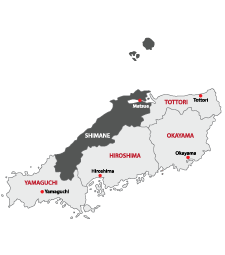 Shimane prefecture sits on the Sea of Japan side of the country, nestled between Tottori and Yamaguchi Prefectures in Western Japan. The prefecture is associated with some of Japan’s most ancient and spiritual spots and is often referred to accordingly as the land of myths or the land of Gods. It is also said to be where sake originated. Access to the prefecture is not easy – no bullet trains service the area, making it an area that takes some time and commitment to reach. Shimane certainly pays back that investment in time and effort with its beauty, rich history, and kind people.
Shimane prefecture sits on the Sea of Japan side of the country, nestled between Tottori and Yamaguchi Prefectures in Western Japan. The prefecture is associated with some of Japan’s most ancient and spiritual spots and is often referred to accordingly as the land of myths or the land of Gods. It is also said to be where sake originated. Access to the prefecture is not easy – no bullet trains service the area, making it an area that takes some time and commitment to reach. Shimane certainly pays back that investment in time and effort with its beauty, rich history, and kind people.
The prefecture can be roughly divided into three areas – the Iwami Area in the West of the prefecture, the Izumo area in the East, and the Oki Islands.
Tsuwano lies in the far West of Shimane, lying in a river valley surrounded by mountains. Tsuwano is known for its picturesque main street, lined with Edo-era buildings and samurai homes, and koi carp ponds. It was a castle town, ruled by the Kamei clan from the 17th to the mid 19th century. It is also famous for the mountainside Taikodani Inari shrine which is the partner shrine to Motonosumi shrine in Yamaguchi prefecture and similarly is characterized by hundreds of vermilion torii gates. In Tsuwano, popular sights include the Otome Toge Maria Chapel, Tsuwano Castle ruins, and the town’s Tonomachi street. For those with a love of steam trains, the SL Yamaguchi travels between Shin Yamaguchi and Tsuwano stations.
Masuda, Hamada, and Gotsu are coastal towns that are worth a stop when traveling between Tsuwarno and Iwami Ginzan. Masuda was the home of monk Sesshu Toyo, known for his Zen gardens and ink paintings, and his garden design can be seen at Manpuku-ji temple in the town. Hamada is Shimane’s third-largest town and offers sandy beaches and hiking trails at the Iwami Seaside Park. For a more natural beach, the Tatamigaura seaside has ancient rock formations. Sekishu washi paper is a local handicraft and here it is possible to learn how washi is made. For those traveling with families, the Aquas aquarium outside Hamada makes an interesting and entertaining stop for little ones. Gotsu, at the mouth of the Gonokawa river, is home to the Shimada kiln and is a focus for the production of Iwami pottery.
Iwami Ginzan, a UNESCO World Heritage Site, is a former silver mine, used for centuries. It is possible to walk through some of the original mineshafts and learn about the dangerous work involved. The silver mine was one of Japan’s largest and remains its oldest, and at its height in the 16th and 17th centuries it produced a third of the world’s silver. The neighbouring town of Omori which grew to service the mine is well worth exploring for an afternoon. Here, the Kigami Shrine with its dragon ceiling, the modest Kumagai merchant house, and the Kawashima samurai residence provide a feel for what life was like for those who made their living from the mine. The Gohyakurakan at Rakanji Temple makes for a sobering visit – the 501 statues of disciples of Buddha are representations of those who lost their lives laboring in the mines.
At the coast, not far from Iwami Ginzan is Yunotsu, a hot springs town near the port of Okidomari, which was once a port for the outgoing silver, and also a hot springs resort in its own right. The onsen has a long history of 1300 years of enjoyment by local people. The current hot springs area and onsen have a bit of a retro feel, harking back to the 1920s and 1930s. The town also has a pottery tradition and one of the longest ascending hillside kilns. Iwami Kagura is famous in the area. This dancing tradition takes place at shrines across the Iwami region and celebrates local mythology, including the defeat of the Orochi.



In the eastern Izumo area of Shimane Prefecture, we find one of Japan’s holiest Shinto sites, Izumo Taisha, known formally as Izumo Oyashiro. In Japanese tradition, October is known outside of Izumo as ‘the month without gods’. In Izumo, it is known as the month of gods, as all the kami or spirits are said to gather in Izumo in the 10th lunar month. They are said to discuss the partnerships and associations that people will have in the year ahead, so it has become known as a shrine for those seeking a partner or good relationships with the people already in their lives. At 24 m tall, the main shrine building is the tallest in Japan, but it is said to be just half of its original height. The shrine’s Kagura hall is bedecked with an enormous shimenawa or sacred rope. The area immediately around the Shrine contains many sub-shrines, as well as shrines that serve to host the incoming gods when they come to visit. The larger shrine grounds contain ponds and iris gardens. The nearby Museum of Ancient Izumo helps to provide insight into the shrine as well as the Shinto faith it serves. The nearby Insasonahama beach features in the shrine’s ceremonies to welcome the gods each year. The picturesque Bentenjima shrine, perched on a tall rock at the beach, projects seafarers.
Between Izumo and Matsue, near Lake Shinji, lies Tamatsukuri Onsen. The Onsen was recorded in Japanese history as far back as the 8th century and by legend is frequented by the gods when coming to Izumo. The onsen is decorated with Magetama – uniquely comma-shaped ‘jewels’ that are said to form part of the sacred regalia from the gods. The shapes can be found throughout the resort. While the onsen welcomes the gods, it also welcomes more earthly visitors. The Momen Kaido, or cotton road, is an interesting route to travel from the Sea of Japan to Lake Shinji near Izumo. The route still has sake dealers, traditional confectioners, oil merchants, soy sauce makers, keeping the flavors of Japan alive. The historic townscapes feature the traditional white-walled storage buildings, now turned to shops.
Matsue is the main city of the prefecture and is home to Matsue Castle. The Castle is one of just 12 original castles remaining in Japan and was built in 1611. It is distinct in having a mostly wooden construction. It is a designated National Treasure and sits on the shore of Lake Shinji. While built as a defensive castle, it never saw battle so remains well preserved. The castle also retains its original moat and it is possible to travel around the moat by pleasure boat. Lake Shinji, one of Japan’s biggest, is famous for its sunsets.
A short walk from the Castle is the Shiomi Nawate street, which features some remaining samurai homes, as well as the form home of Lafcadio Hearn, a writer and poet of Irish and Greek lineage who made his home in Japan and wrote in both English, and Japanese under his Japanese name of Koizumi Yakumo.
On the outskirts of Matsue, the Adachi Museum of Art has a rich collection of 1500 works of art and pottery and has a globally recognized collection of Japanese art. The museum’s gardens are as much an attraction as the museum itself, with 6 different types of Japanese gardens illustrated. East of Matsue, the Yushien gardens are a must for those with a love of peonies with indoor and outdoor displays allowing for year-round viewing.
For a natural adventure in the Shimane area, the Oki Islands fit the bill. The Oki Islands consist of 4 inhabited islands, and many smaller islands, lying off the coast of Shimane Prefecture in the Sea of Japan. They have been designated a UNESCO Global Geopark, the Daisen-Oki National Park, and have their endemic species of trees and animals in what is a naturally beautiful area with dramatic scenery with the grassy topped but stark Matengai cliff, and sea arches created by years of natural erosion. A cruise around the Kuniga coastline showcases both the area’s clear waters and the power of nature. The four main inhabited islands of Dogo, Nakanoshima, Nishinoshima, and Chiburijima offer opportunities to swim and snorkel and enjoy the beaches in the warm summer months, and year-round opportunities exist for hiking and exploring the natural habitat.



